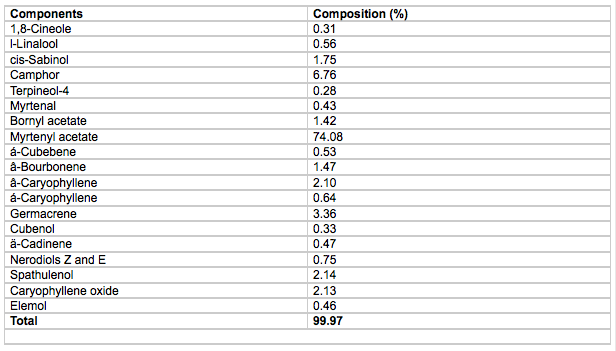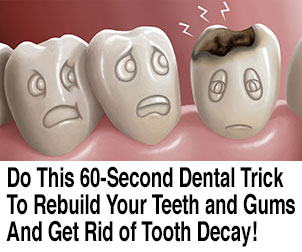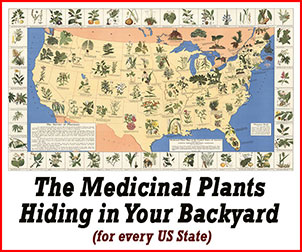Hyssop
Background & General Info
Hyssop, or Hyssopus officinalis, is a perennial herb mainly distributed in Southern Europe, the Middle East, and the Caspian Sea region. It has a slightly bitter taste but pleasant “sage-like” odor and is nonetheless used in food industries as a condiment with minty flavor. [1]

Hyssop - Botany
Hyssop is a pubescent, branched shrub. Its linear to lanceolate, dark green leaves are glabrous, scabrous, and glandular. These leaves are also finely strigose along their slightly involute margins and have an attenuate to cuneate base. Its axillary verticillasters bear three to seven flowers with bluish to purple corolla and are situated in spikes or sometimes panicles. [2]
Hyssop - History & Traditional Use
Hyssop owns a long history of medicinal and culinary use. [3] It has even been mentioned in the Old Testament of the Bible wherein Moses instructed all elders of Israel to “take a bunch of hyssop and dip it in the blood that is in the basin” prior to the Israelites’ departure out of Egypt. [4] In the past, this aromatic medicinal plant was used to spiritually purify sacred temples during rituals and to cleanse lepers. [3] In Iran where it is referred to as zufa, it is traditionally employed as a carminative, tonic, antiseptic, expectorant, and cough reliever. [1]
Hyssop - Herbal Uses
A number of studies have scientifically provided merit to the traditional use of hyssop and identified several biologically active constituents with antioxidant, anti-platelet, free radical-scavenging, hypoglycemic, and antifungal activities. [1] Other valuable therapeutic properties have also been reported for hyssop extracts and essential oils, including spasmolytic, antiviral, sudorific, emmenagogue, carminative, tonic, diuretic, expectorant, antiseptic, and antibacterial effects. [3] Hyssop can relieve cough, asthma, fever, and rheumatism and can serve as an anti-inflammatory agent. [5] Hyssop preparations are also purportedly effective as remedy for digestive and intestinal conditions such as intestinal pain and gas, appetite loss, and liver and gall bladder disorders and can relieve menstrual pain and cramps. [3]

Hyssop - Constituents / Active Components
The phenolic profile of hyssop ethanol extract consists of different concentrations of phenolic acid derivatives (caftaric, gentisic, caffeic, p-coumaric, chlorogenic, and ferulic acids), flavonoid glycosides (rutin, isoquercitrin, and quercitrin), and free flavonoid aglycons (luteolin, quercetin). [6] The major components of the two hyssop essential oils analyzed by Fraternale et al. (2004) were pinocamphone (34% and 18.5%), isopinocamphone (3.2% and 29%), and β-pinene (10.5% and 10.8%). [7] The composition of hyssop essential oil is presented below, as identified by Fathiazad et al. (2011) through gas chromatography–mass spectrometry (GC–MS) analysis. [1]

Hyssop - Medicinal / Scientific Research
Antioxidant:
Hyssop exhibits good antioxidant activity because of its abundant polyphenolic compounds (77.72 mg/g). [6] Findings of a 2011 Iranian study demonstrated the potent antioxidant property of hyssop, whose n-butanol and ethylacetate extracts had been determined to have a total phenol content of 246 mgGAE/g and 51 mgGAE/g, respectively, as evaluated spectrophotometrically through the Folin–Ciocalteau procedure. In this study, apigenin 7-O-β-D-glucuronide was identified as the chief flavonoid of hyssop’s aerial parts, and DPPH radical scavenging assay revealed its antioxidant activity, with IC50 value of 116 × 10−3 mg/mL. [1]
Anti-inflammatory:
Hyssop had been shown to influence the levels of numerous cytokines in asthmatic mice, such as interleukin-4, interleukin-6, and interleukin-17 and interferon-γ. [8]
Antifungal:
A 1997 French study demonstrated the antifungal property of hyssop essential oil against Aspergillus fumigatus, one of the most common fungi to cause allergic diseases, respiratory illnesses, and bloodstream infections in immunodeficient individuals. Culturing cell walls of Aspergillus fumigatus hyphae with hyssop essential oil led to decreased levels of their neutral sugars, uronic acid, and proteins but increased levels of amino sugars, lipids, and phosphorus. Hyssop essential oil also produced noticeable changes in the content of galactose and galactosamine in the fungus’ cell walls. [9] A 2001 series of in vitro and in vivo experiments demonstrated the fungicidal effects of hyssop essential oil and its volatile components, which were both shown to completely inhibit the mycelial growth of the pathogenic fungi Pyrenophora avenae and Pyricularia oryzae. [10] Fraternale et al. (2004) also confirmed the antifungal activity of hyssop essential against 13 strains of phytopathogenic fungi. [7]
Antiviral:
Hyssop essential oil was examined in a 2008 German study for its antiviral activity against herpes simplex virus type 2 (HSV-2) in vitro. Using a plaque reduction assay, inhibitory concentration (IC50) of hyssop essential oil was determined to be 0.0075% on RC-37 cells and its apparent dose-dependent virucidal activity against HSV-2 had been established. A significant reduction of plaque formation of more than 90% had also been observed during preincubation of HSV-2 with hyssop essential oil at its maximum noncytotoxic concentration. This indicated that this essential oil exerted its action on HSV-2 chiefly prior to adsorption by interacting with the viral envelope. [11]
Muscle-relaxing:
Lu et al. (2002) confirmed the muscle-relaxing action of hyssop essential oil and its chief constituents on isolated preparations of guinea pig and rabbit intestine. It was shown that hyssop essential oil and its isopinocamphone both concentration-dependently prevented contractions experimentally elicited by acetylcholine and BaCl2b in guinea pig ileum. Furthermore, hyssop essential oil also inhibited the contractions induced by CaCl2 in guinea pig ileum and diminished the amplitude of spontaneous movements and reduced the basal tone in isolated rabbit jejunum. [12]
Stimulative:
By employing a forced swimming test in mice, Lim et al. (2005) determined the stimulative effect of hyssop essential oil following its inhalation. Such inhalation of hyssop essential oil resulted in increased immobility and significantly augmented the immobile state of overly agitated mice treated with caffeine. [13]
Spasmolytic:
The spasmolytic effect of hyssop essential oil and its major components was evaluated by Mazzanti et al. (1998) on isolated guinea pig ileum contracted by acetylcholine and BaCl2. Hyssop essential oil (IC50 values of 37 μg/mL and 60 μg/mL) and linalool (IC50 values of 10 μg/mL and 51 μg/mL) was proven to effectively block the contractions induced by acetylcholine and BaCl2 in a concentration-dependent manner, with such antagonism seeming to be noncompetitive in nature. However, other constituents of hyssop essential oil, namely, 1,8-cineole and limonene, exerted only a weak spasmogen activity. [14]
Asthma:
Ma et al. (2014) demonstrated the therapeutic benefit of Hyssopus officinalis L. on airway immune regulation and airway inflammation in a mouse model of chronic asthma. Specifically, hyssop inhibits airway inflammation by suppressing eosinophil invasion and decreasing IgE levels. It was observed that the ratio of eosinophils in the bronchoalveolar lavage fluid of chronic asthmatic and dexamethasone-treated mice increased following hyssop treatment. According to results from an enzyme-linked immunosorbent assay, their level of serum IgE also increased but that of serum IgG decreased, indicating hyssop’s effect on immune regulation. [8] In another 2014 study about the effect of hyssop on airway remodeling (the chief pathological feature of asthma) in asthmatic mice, treatment comprising dexamethasone and hyssop decreased the expression of MMP-9 and TIMP-1 and ameliorated the pathological changes, such as collagen deposition, mucus secretion, and smooth muscle proliferation. Hyssop appeared to also relieve deposition in the ECM by regulating the MMP-9/TIMP-1 ratio and by preventing smooth muscle thickening, goblet cell hyperplasia, and fibrosis. [5]
HIV/AIDS:
Hyssop extracts contain compounds possessing strong anti-HIV property such as caffeic acid and tannins, making them potential candidate as alternative treatment for patients with AIDS. Crude extracts obtained from the dried leaves of Hyssop officinalis had been demonstrated by an early 1990 study to exhibit strong anti-HIV activity, as evaluated through inhibition of syncytia formation, HIV reverse transcriptase, and p17 and p24 antigen expression. The ether and methanol extracts (and even the residual material after methanol extraction) also displayed very strong antiviral activity. [15]
Hyssop - Contraindications, Interactions, And Safety
Hyssop is classified as “generally recognized as safe” by the FDA, with no clear contraindications and clinical trials of drug or supplement interactions having been identified. [16] In the study of Kreis et al. (1990), crude extracts from dried hyssop leaves were nontoxic to uninfected Molt-3 cells. [15] Toxicity from hyssop essential oil can lead to tonic-clonic convulsions as its major symptom, as reported by an early 1981 study involving human intoxication in eight cases due to use of commercial preparations of hyssop. This experimental study in unanesthetized rats determined the convulsant action of hyssop to be of central nervous system origin based on electrocortical records and associated hyssop oil's toxicity with its pinocamphone content. At a dose of 0.13 g/kg of hyssop essential oil, convulsions occur, whereas more than 1.25 g/kg can become lethal. [17]
Hyssop has long been conventionally used as an emmenagogue and abortifacient; thus, its use is strongly not recommended during pregnancy unless under the supervision of a qualified healthcare professional. Safety while lactating has not also been concretely established, although it remains that no information has pointed out any concern for use while nursing. [16]
References:
[1] F. Fathiazad, M. Mazandarani and S. Hamedeyazdan, "Phytochemical analysis and antioxidant activity of Hyssopus officinalis L. from Iran," Advanced Pharmaceutical Bulletin, vol. 1, no. 2, p. 63–67, 2011. https://www.ncbi.nlm.nih.gov/pubmed/24312758
[2] "Hyssopus officinalis Linnaeus," Flora of China. https://www.efloras.org/florataxon.aspx?flora_id=2&taxon_id=200019722
[3] A. Judzentiene, "Hyssop (Hyssopus officinalis L.) oils," in Essential Oils in Food Preservation, Flavor and Safety, Cambridge, Massachusetts: Academic Press, 2015, p. 471–478.
[4] Journal of the Royal Asiatic Society of Great Britain and Ireland, London: Royal Asiatic Society of Great Britain & Ireland, 1846.
[5] X. Ma, X. Ma, Z. Ma and et al., "The Effects of Uygur herb Hyssopus officinalis L. on the process of airway remodeling in asthmatic mice," Evidence-based Complementary and Alternative Medicine, vol. 2014, p. 710870, 2014. https://www.hindawi.com/journals/ecam/2014/710870/
[6] L. Vlase, D. Benedec, D. Hanganu and et al., "Evaluation of antioxidant and antimicrobial activities and phenolic profile for Hyssopus officinalis, Ocimum basilicum and Teucrium chamaedrys," Molecules, vol. 19, no. 5, p. 5490–5507, 2014. https://www.ncbi.nlm.nih.gov/pubmed/24786688
[7] D. Fraternale, D. Ricci, F. Epifano and M. Curini, "Composition and antifungal activity of two essential oils of hyssop (Hyssopus officinalis L.)," Journal of Essential Oil Research, vol. 16, no. 6, p. 617–622, 2004. https://agris.fao.org/agris-search/search.do?recordID=US201300958762
[8] X. Ma and et al., "Effect of Hyssopus officinalis L. on inhibiting airway inflammation and immune regulation in a chronic asthmatic mouse model," Experimental and Therapeutic Medicine, vol. 8, no. 5, p. 1371–1374, 2014. https://www.ncbi.nlm.nih.gov/pubmed/25289025
[9] B. Ghfir, J. Fonvieille and R. Dargent, "Influence of essential oil of Hyssopus officinalis on the chemical composition of the walls of Aspergillus fumigatus (Fresenius)," Mycopathologia, vol. 138, no. 1, p. 7–12, 1997. https://www.ncbi.nlm.nih.gov/pubmed/16333566
[10] M. Letessier, K. Svoboda and D. Walters, "Antifungal activity of the essential oil of hyssop (Hyssopus officinalis)," Journal of Phytopathology, vol. 149, no. 11–12, p. 673–678, 2001. https://onlinelibrary.wiley.com/doi/10.1046/j.1439-0434.2001.00692.x/abstract
[11] C. Koch, J. Reichling, J. Schneele and P. Schnitzler, "Inhibitory effect of essential oils against herpes simplex virus type 2," Phytomedicine, vol. 15, no. 1–2, p. 71–78, 2008. https://www.ncbi.nlm.nih.gov/pubmed/17976968
[12] M. Lu, L. Battinelli, C. Daniele and e. al., "Muscle relaxing activity of Hyssopus officinalis essential oil on isolated intestinal preparations," Planta Medica, vol. 68, no. 3, p. 213–216, 2002. https://www.ncbi.nlm.nih.gov/pubmed/11914956
[13] W. Lim, J. Seo and et al., "Stimulative and sedative effects of essential oils upon inhalation in mice," Archives of Pharmacal Research, vol. 28, no. 7, p. 770–774, 2005. https://www.ncbi.nlm.nih.gov/pubmed/16114490
[14] G. Mazzanti, M. Lu and G. Salvatore, "Spasmolytic action of the essential oil from Hyssopus officinalis L. var. decumbens and its major components," Phytotherapy Research, vol. 12, no. S1, p. S92–S94, 1998. https://onlinelibrary.wiley.com/doi/10.1002/(SICI)1099-1573(1998)12:1+%3CS92::AID-PTR261%3E3.0.CO;2-9/abstract
[15] W. Kreis, M. Kaplan and et al., "Inhibition of HIV replication by Hyssop officinalis extracts," Antiviral Research, vol. 14, no. 6, p. 323–337, 1990. https://www.ncbi.nlm.nih.gov/pubmed/1708226
[16] Z. Gardner and M. McGuffin, "Hyssopus officinalis L.," in American Herbal Products Association’s Botanical Safety Handbook, 2nd ed., Boca Raton, Florida: CRC Press, 2013, p. 466–467.
[17] Y. Millet, J. Jouglard, M. Steinmetz, P. Tognetti, P. Joanny and J. Arditti, "Toxicity of some essential plant oils. Clinical and experimental study," Clinical Toxicology, vol. 18, no. 12, p. 1485–1498, 1981. https://www.ncbi.nlm.nih.gov/pubmed/7333081
Article researched and created by Dan Ablir for herbshealthhappiness.com.
© herbshealthhappiness.com


1. Famous Chef Sheds 60lbs Researching New Paleo Recipes: Get The Cookbook FREE Here
2. #1 muscle that eliminates joint and back pain, anxiety and looking fat
3. Drink THIS first thing in the morning (3 major benefits)
4. [PROOF] Reverse Diabetes with a "Pancreas Jumpstart"
5. Why Some People LOOK Fat that Aren't
6. Amazing Secret Techniques To Protect Your Home From Thieves, Looters And Thugs
7. The #1 WORST food that CAUSES Faster Aging (beware -- Are you eating this?)
![]()
![]()
![]()
If you enjoyed this page:






























